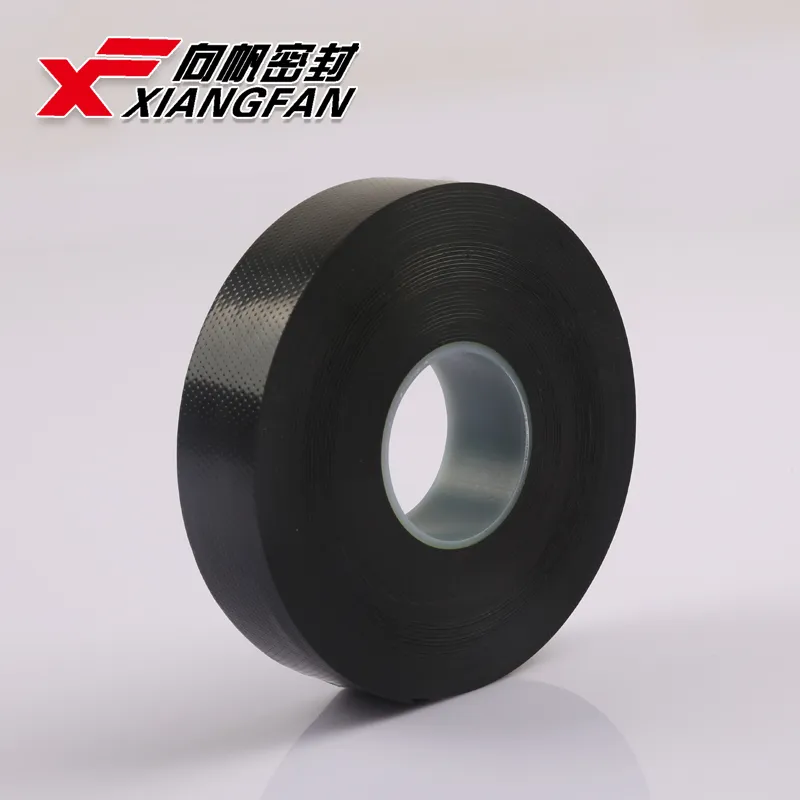Rubber Electrical Tape. Pads, Helps Protect and Insulate up to 69kV.
-

Primary Insulation helps keep the lights on.
Electricians have critical jobs. Keeping our world powered requires concentration, knowledge and skill. Some of the most dangerous work is done by electricians working on medium and high voltage applications. Ethylene propylene and silicone rubber electrical tapes have the highest dielectric rating of electrical tapes made by 3M and are a trusted product in the toolbox of most medium and high voltage linemen and installers. With proper wrapping, their self-fusing properties help to eliminate voids in critical areas that may cause catastrophic failures .
But there is more. Pros know that rubber tapes can offer more than just high voltage insulation and are often used in a variety of low voltage applications as well.
Shouldn’t snap when you wrap.
-
Wrapping tape on a high voltage cable can be time consuming and error prone since the careful build-up of tape requires accurate half-lapping and constant tension in order to reduce build-in air voids. Rubber tapes are designed to stretch−some up to 1000%. Elongating the tape this way drives to compression, and that results in the strong self-fusion that provides great insulation and moisture protection.
In a typical tape splice, you’ll tug and pull out the tape, stretching it to just before the breaking point. The tape’s width narrows to about 1/3rd of its original size. The tape’s length increases; your hand travels very quickly up to 20” away from where you started. Quite often you’ll be wrapping in a tight location making this even more difficult. Proper taping techniques are critical to realizing the many performance benefits of rubber tape.
-
- Backwinding rubber tape allows you to tuck the excess back onto the roll as you work, pacing out more as you make your half laps around the cable and helping prevent the tape from getting progressively further away from the work area.
- Even pressure on the stretch helps eliminate voids and bulges, sometimes called ‘pregnant splices’.
- A good rubber tape won’t snap and break when you wrap.
- Splices and terminations should always be jacketed with vinyl tape for protection from chemical contaminants and physical damage. Vinyl jackets help keep your cable from collecting debris.
- Dielectric strength of rubber tape increases as you add layers. For low-voltage applications (<600V), always apply a minimum of 2½ half-lapped layers.
Moisture Control
Self-bonding helps makes an air and watertight seal.
-
Rubber tapes repel moisture and are a great solution for outdoor applications or in manholes where water may occasionally seep in.
In production plants and manufacturing facilities where steam, dripping water and elevated humidity are present, self-fusing rubber tapes provide much needed moisture protection.
In a harsh environment, one that is subject to chemical and harsh fluid exposure; overwrap with a hearty vinyl tape to help prevent copper corrosion
-
Anyone who’s left a roll of general purpose vinyl tape in the cab of their truck on a very hot summer day can attest to the fact that heat makes the adhesive soft. Extreme heat makes it ooze and flow.
3M rubber tapes have operating temperatures ranging from 176°F (80°C) to 221°F (105°C). Some, Linerless Rubber Splicing Tape 130C and Rubber Splicing Tape 23, have overloads temperatures up to 266°F (130°C). Because of this high heat attribute; there are many industrial settings where it is common to use rubber tape in lower voltage applications to moisture seal, pad and insulate:
- Production lines with blasting furnaces
- Steel mills
- Near heat vents
- Machines and motors which run hot
Wait, it gets hotter.
3M also makes an electrical tape made of silicone rubber for applications where Class “H” (180°C/356°F) temperatures are encountered i.e., silicone rubber cables.
- Self-Fusing Silicone Rubber Electrical Tapes 70 and 70HDT offer very light weight, thin profiles for environmental sealing, insulation (typically 5 to 46kV), UV resistance and track and arc protection in very hot applications.
- 70HDT has a triangular profile, thicker in the middle. This tape is designed to create a uniform surface height when half-lapped.
- These features can also be extremely important in applications such as naval, military and air craft manufacturing, where limiting weight and minimizing space are critical.
-
Mastic is a very tacky material with extreme elongation properties. Rubber mastic tape combines an ethylene propylene rubber backing with a conformable mastic layer.Rubber Mastic Tape 2228 integrates some of the best qualities of both materials−higher temperature rating, conformability, dielectric strength. It’s one tape that belongs in every toolkit.
Long lasting applications + great for quick fixes.
-

The key to selecting the right electrical tape for your application.
There are some basic rules to follow when you’re selecting electrical tape.
- Vinyl backed tapes have a strong, flexible, abrasion resistant PVC backing which provide a barrier from moisture and corrosive elements. They are often the first and most economical choice for primary and secondary insulation.
- Mastic tapes offer excellent adhesion and sealing characteristics to metals, rubbers, synthetic cable insulations and jackets. They provide UV resistance and are designed for outdoor conditions because they quickly and easily seal out moisture.
- Rubber tapes are designed for use in splicing and terminating wires and cables with options rated up to 69kV. They have excellent physical and electrical properties and are ideal for adding moisture protection and padding to electrical connections and cables.
Get more information on product selection, applications and training in our Electrical Resource Center.
-
Versatility with Tape Electrical InsulationNewsJun.09,2025
-
Floor Marking Tapes For WareHouseNewsJun.09,2025
-
Enhance Your Projects with PVC Electrical TapesNewsJun.09,2025
-
Enhance Your Projects with Automotive Wiring Harness TapeNewsJun.09,2025
-
Enhance Your Automotive Fabric TapesNewsJun.09,2025
-
Enhance Electrical Projects with Cambric TapeNewsJun.09,2025

